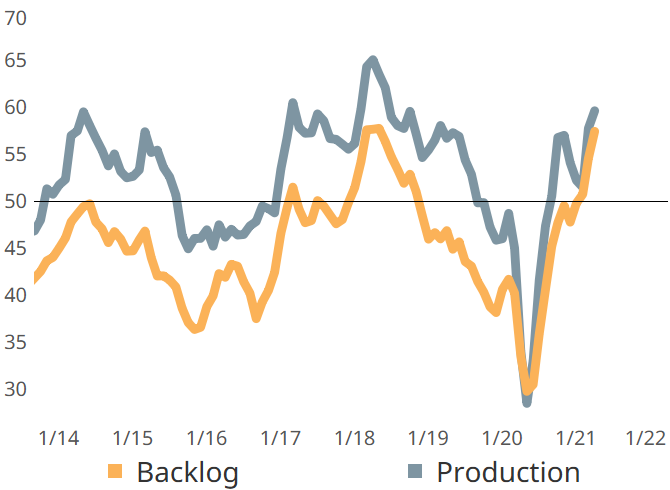Finishing Index Moderates After Posting March All-Time High
Best Efforts to Increase Output Still Cannot Quell Rising Backlogs
#economics
The Products Finishing Index fell just over 1 point in April to close at 62.7. Declining readings above 50 indicate slowing expansion. Among the six business activities which constitute the Finishing Index, the readings for supplier delivery and backlog activity moved higher. Their gains were more than offset by slowing expansion in new orders, production and employment, and lastly by contracting backlog activity.
The last six months have seen an unbroken series of accelerating readings, the last five of which all set new all-time highs. The signal sent by such readings is that a growing majority proportion of finishers are experiencing lengthening order-to-fulfillment times for the goods necessary to meet their production targets. Further, despite finishers’ best efforts to expand production and employment, such efforts have not been able to fully meet demand as evidenced by backlog readings. During the year-to-date period, a quickly growing proportion of surveyed finishers have reported expanding backlogs with April’s reading besting the prior all-time high set in early 2018. Although efforts to expand production are being met with limited success, these efforts have in part driven material costs higher, with at least 85% of respondents citing rising costs in April.
Products Finishing Index

The Products Finishing Index moderated during April as rising supplier delivery and backlog activity were offset by declining readings for new orders, production, employment, and exports.
Strong New Orders Causing Backlog Surge

Surging new orders activity since the beginning of the year coupled with distressed supply chains have resulted in quickly rising backlogs.
RELATED CONTENT
-
Acid Zinc-Nickel Benefits Market Share
Stephen Roberts of Columbia Chemical discusses the advantages of adding acid zinc-nickel capabilities to your plating operation.
-
Henry Ford Is Still Right When It Comes to Color
Who would have imagined that more than 100 years after his famous statement about any color as long as it’s black would still have relevance of a sort?
-
Automotive Powder Coating
The automotive market and its requirements for powders...


.jpg;width=70;height=70;mode=crop)













